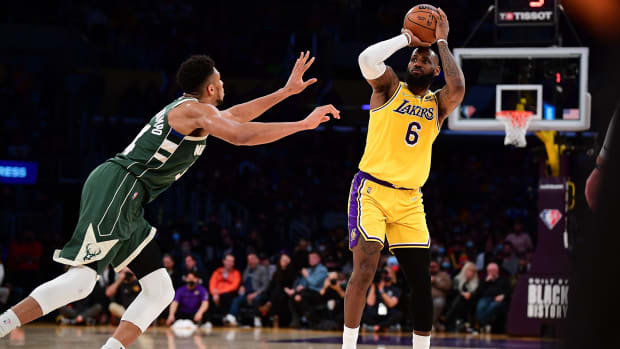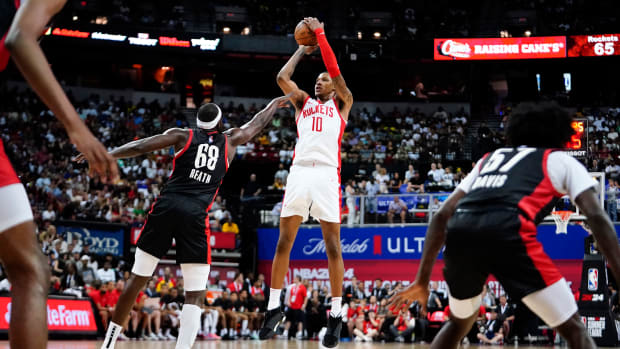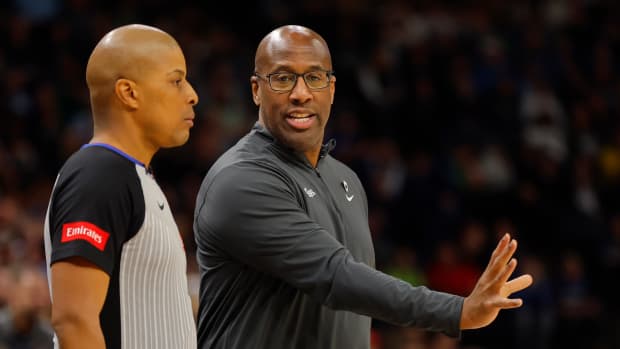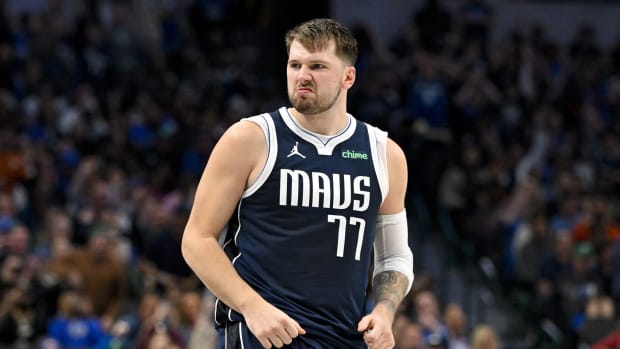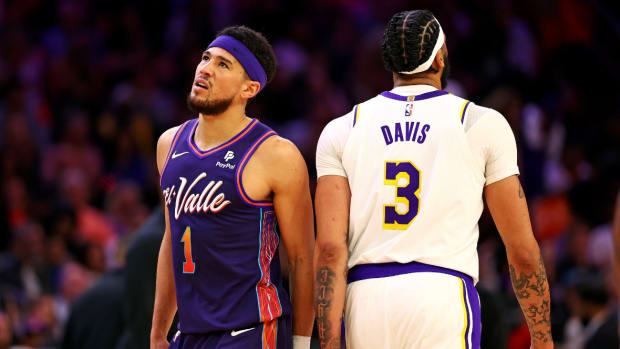Kawhi Leonard vs. Nike: Analyzing the Raptors Star's Logo Lawsuit
Has Nike misappropriated the intellectual property of Toronto Raptors star Kawhi Leonard or did Leonard unwisely contract away that property? Could this controversy impact how NBA teams pursue him as a free agent this summer?
We’ll soon find out the answers to these questions. On Monday, Leonard filed a copyright infringement lawsuit against Nike in the U.S. District Court for the Southern District of California. The case has been assigned to Judge Cynthia Bashant, a former Assistant U.S. Attorney who presides over trials in San Diego’s Edward J. Schwartz U.S. Courthouse.
Leonard is represented by several attorneys including Sullivan and Worcester’s Peter Ginsburg, who has litigated on behalf of Jonathan Vilma, Ray Rice and Vijay Singh and other pro athletes, and Scott Metzger of San Diego’s Duckor, Spradling, Metzger & Wynne.
Leonard demands a declaration that he is the author of the logo
As Leonard’s season continues with the Raptors and Golden State Warriors tied up at 1-1 in the NBA finals, he seeks several remedies from the legal system.
First, Leonard demands a declaration that he is the sole author of what his attorneys label the “Leonard Logo.” One current version of the logo appears on Leonard’s Twitter page, @kawhileonard:
The origin of the Leonard Logo, at least as depicted in Leonard’s complaint, traces back to Leonard’s days as a college star for San Diego State from 2009 to 2011.
It was during Leonard’s time with the Aztec Warriors when he “contemplated and conceived of ideas for a personal logo.” The logo was intended to reflect Leonard’s image and likeness and the special qualities that make him such a uniquely gifted player. One such quality is Leonard’s large hands, which help him to excel defensively and have led to the nicknames “The Hand” and “The Claw.”
Leonard’s hands have become renowned in NBA circles. In an interview on ESPN last week, Los Angeles Clippers head coach Doc Rivers highlighted Leonard’s “big hands” when listing the physical and mental talents of Leonard that resemble those of Michael Jordan. In response, the NBA imposed a $50,000 fine on the Clippers—who, along with the Los Angeles Lakers, New York Knicks, Brooklyn Nets and Raptors are expected to be frontrunners for Leonard’s services in free agency. The flattering Michael Jordan comparison constituted tampering since it could be construed as an attempt by Rivers to lure Leonard, who is obviously still under contract to the Raptors, to the Clippers.
Long before he was compared to greatest player in NBA history, Leonard, 27, was a less heralded player who smartly valued the intellectual property associated with his image and basketball career. By January 2012—five months into Leonard’s rookie season with the San Antonio Spurs—the Los Angeles native had “refined” the logo. This refined logo, as Leonard’s attorneys tell it, encompassed “his large and powerful hands, his initials and his jersey number.”
The complaint aggressively asserts that the Leonard Logo was truly Leonard’s creation, and thus not the invention of a marketing firm or of any expert retained by an apparel company. The complaint also suggests that witnesses would be able to corroborate Leonard’s retelling of history. “Leonard,” the complaint stresses, “shared his original work of authorship with family and friends.” Leonard also consulted with an unnamed creative designer and other experts whom he trusted. Leonard took their feedback and modified the design, though he insists that the design fundamentally reflects his vision.
Leonard demands a ruling that he has not interfered with Nike
Leonard also seeks a court declaration that the Leonard Logo doesn’t infringe any rights of Nike, including any rights that Nike might claim it possesses in the Leonard Logo or in any related logos.
To that end, Leonard’s complaint details his former endorsement relationship with Nike. Obviously, the retelling of that relationship is through the lens of Leonard, who is not neutral. He is the plaintiff in a lawsuit brought against Nike.
Leonard’s ties to Nike also ended on less than amicable terms. Last March, Nike’s Jordan Brand announced that it would not re-sign Leonard after he rejected a four-year offer worth $22 million. Leonard now endorses New Balance, a rival of Nike. New Balance inked Leonard to a multi-year deal last November and undoubtedly wants to maximize the exclusivity—and accompanying value—of Leonard’s intellectual property. Leonard attempting to limit Nike’s use of his intellectual property through litigation therefore serves both his interests and those of his new sneaker company.
With those caveats in mind, Leonard’s complaint details how he and Nike signed a three-year endorsement deal in October 2011. The deal obligated Leonard to provide “personal services and expertise in the sport of professional basketball and endorsement of the Nike brand and use of Nike products.”
At least as articulated by Leonard’s attorneys, the deal neither contemplated a transfer or formal license of Leonard’s intellectual property to Nike nor did it acknowledge that Leonard’s work on the logo would inure to the benefit of Nike. It’s possible that Nike might provide contractual language that paints a different picture.
Leonard signed his deal with Nike right as his rookie season with the Spurs had begun. While clearly a gifted player, Leonard was neither a lottery pick nor expected by most basketball experts to develop into a superstar. This was apparent during the 2011 NBA Draft. The Indiana Pacers selected Leonard with the 15th pick, after he had been passed over for Derrick Williams (2nd), Jan Veselý (6th) and Jimmer Fredette (10th) and several other players whose NBA careers have since ended or are hanging on by a thread. The Pacers didn’t even keep Leonard, instead dealing him to the Spurs for George Hill, a solid though unspectacular guard.
Nike’s investment in a somewhat-overlooked Leonard proved shrewd. He quickly became a key member of Gregg Popovich’s squad and played a crucial role in the Spurs defeating the Miami Heat in the 2014 NBA finals. He was named the MVP of those Finals. Aided by his distinctively large hands, Leonard also led the NBA in steals per game during the ’14-’15 season. He morphed into superstardom by no later than the ’15-’16 season. Leonard was awarded the NBA’s Defensive Player of the Year Award that season while averaging 21 points per game. Measured by both traditional and advanced metrics, Leonard had come into his own.
As Leonard became a household name among NBA fans, Nike negotiated extensions of its original endorsement deal. The company’s relationship with Leonard would last until September 30, 2018. Leonard acknowledges that during the seven years he was affiliated with Nike, Nike had approached him about “creating a unique logo to affix to merchandise to be sold under the Nike Agreement.” To that end, Nike offered suggestions to Leonard on how he might change the Leonard Logo—the same one that Leonard says he conceived of in college.
Leonard insists that, “for the most part,” he rejected Nike’s suggestions on how to alter the Leonard Logo. Leonard preferred his own vision. However, Leonard authorized Nike to propose variations of the log so long as the company understood that Leonard retained final control over any use of the logo or its variations in commercial activities.
Leonard says that Nike designed variations of the Leonard Logo, but he contends that he rejected most of them.
One exception occurred in June 2014. Leonard was comfortable with a proposed alteration of the Leonard Logo. He authorized Nike to affix this logo on various Nike merchandise. It appears that the authorization may have been connected to one of Leonard’s contract extensions with Nike.
Leonard’s representatives allegedly reiterated to Nike that while Leonard was effectively licensing his logo to Nike for pre-approved uses, Leonard continued to own the logo. Likewise, Leonard rejects any notion that he transferred ownership of the logo. Text messages and emails, Leonard’s attorneys insist, corroborate this account. Further, Nike officials allegedly used the moniker “Kawhi’s Logo” in written communications, a possessive phrase that Leonard contends is additional evidence that Nike accepted Leonard’s ownership of the Leonard Logo.
In addition, Leonard and his agents repeatedly used the Leonard Logo in a variety of non-Nike contexts and without permission by Nike. Those uses included basketball camps, charity events and appearances, as well as non-Nike apparel and merchandise. Meanwhile, Leonard’s representatives relayed to Nike instances where third-parties were impermissibly using the Leonard Logo and Nike agreed to assist in halting such use.
Nike and Leonard file dueling intellectual property registrations
This apparent, if informal, “meeting of the minds” between Leonard and Nike over the Leonard Logo would collapse in May 2017. That month, the U.S. Copyright Office granted Nike’s application to register the “Kawhi Leonard Logo.”
Leonard’s attorneys insist that neither Leonard nor anyone representing him was made aware that Nike had applied for copyright registration or that it had been granted. On the application, Nike claimed to have owned the logo and to have created it in 2014—several years after Leonard insists that he invented it.
Nike’s ability to gain a copyright registration in the logo provides several advantages to the company. A copyright refers to the exclusive right to reproduce, publish or sell an original work. Registration enables its holder to claim presumptive ownership in the work; pursue infringement cases in federal court and avail itself of protections from U.S. Customs to combat counterfeit goods (a significant concern for Nike and other sneaker companies).
Five months later, Leonard struck back. He applied to the U.S. Patent and Trademark Office and was subsequently granted registration for trademarks in the Leonard Logo. Leonard’s application noted that he had developed the logo and used it for various products, including non-Nike products. One such logo consisted of an image of his hand, initials and jersey number. Trademark registration provides similar benefits as copyright registration in that both help a holder of the registration argue that they are the legally-recognized owner. Leonard maintains that he is the owner of the Leonard Logo and has “permitted” Nike to it for uses that Leonard must approve.
Leonard and Nike’s competing ownership interests in Leonard Logo came to a head at the end of 2018—not long after Leonard had signed with New Balance. In December 2018, John Matterazzo, Nike’s Vice President and Global Counsel for Sports Marketing, wrote a letter to Leonard’s representatives claiming (at last as depicted by Leonard) that Nike asserts ownership in the Leonard Logo pursuant to both its 2011 endorsement deal with Leonard (and subsequent extension) and its copyright registration.
The letter therefore suggests that Leonard’s contributions to the Leonard Logo during his association with Nike were a “work made for hire.” Nike thus contends that Leonard—whom Nike paid millions of dollars—was purportedly hired in part to cultivate his own logo. Under this interpretation, Leonard’s contributions were contemplated by his contract with Nike and thus legally owned by Nike. Nike’s position on work made for hire was, as noted by IP attorney Will Maguire, also apparent in its copyright registration. Further, Nike’s letter to Leonard purportedly included a demand that Leonard cease using the Leonard Logo on non-Nike merchandise, including New Balance merchandise.
In January of this year, Leonard’s attorneys responded to Nike by essentially telling the company no way. Leonard maintains that he owns the Leonard Logo. His attorneys have reiterated Leonard’s different claims to ownership: Leonard invented the logo in college and developed it over subsequent years; Nike allegedly acknowledged that Leonard owned the logo; and Leonard registered the logo with the U.S. Patent and Trademark office.
Leonard intends to use the logo in connection with apparel and footwear (presumably with New Balance) and with various sports camps and charity events. In March, Nike responded in a letter demanding that Leonard immediately cease and desist from using what Nike claims is Nike property. Leonard sued Nike on Monday.
How the litigation could play out
The most likely resolution to the litigation is that Leonard and Nike reach a settlement where Nike acquiesces to Leonard and the companies with whom he is now affiliated can use the Leonard Logo. Such a settlement would involve a resolution of ownership, with the owner then agreeing to license the use for a cost. Under this arrangement, Leonard would pay Nike a fee or percentage of earnings from endorsements. Nike, then, would financially gain from Leonard financially gaining.
That’s not to say a settlement is a sure thing. Nike may want to litigate for a while. Battles between sneaker companies over athletes are legendary. Nike may see a “win” in preventing or at least limiting New Balance’s efforts to profit off its relationship with Leonard. On the other hand, Leonard’s future value to Nike is questionable given that he is no longer a Nike sponsored athlete. He is associated with a rival sneaker company, which would seemingly make it unwise for Nike to promote him. If Nike could receive a portion of earnings it might be placated.
Nike is also presumably mindful that if it has an acrimonious legal battle with a superstar player, that could adversely impact its recruitment of other superstar players. Those players likely do not want to sign with companies that have a track record of litigating against its former clients.
Still, before a settlement is reached, the two sides will litigate. Nike will answer Leonard’s complaint. The answer will raise arguments discussed in detail above. A key one will be Nike’s assertion that the endorsement contract(s) Leonard signed with Nike contemplate him developing the logo as part of his compensation to Nike. Stated differently, Nike will maintain that it hired Leonard in part to bolster a logo and that Nike owns the fruits of Leonard’s contributions.
Nike would strengthen this argument by showing excerpted language from the endorsement contracts to support this assertion. If the endorsement contracts only say that Leonard agreed to promote Nike’s products, Nike would face difficulty in claiming that Leonard also took on a creative development role for the company.
Leonard, for his part, would bolster his chances by furnishing tangible evidence that he created the logo while in college. Any artistic depictions of the Leonard Logo from his college days would prove helpful. Similarly, corroborating witness testimony—ideally testimony from witnesses who have no stake in the outcome of the litigation, rather than Leonard’s family members and friends—would assist him in the litigation.
Both sides are also inclined to hire expert witnesses from the sneaker and endorsement industries. Leonard’s experts would argue that an endorsement contract does not contemplate transfer of IP ownership or work for hire unless the contract expressly says as much. In contrast, Nike’s experts would contend that Leonard’s failure to seek registration in the logo until after Nike did so suggests that he did not regard himself as the owner.
How other NBA players—and their agents—can learn from Leonard’s litigation
The fundamental reason for Leonard and Nike disputing ownership of the Leonard Logo is their failure to contractually resolve the issue. This was an avoidable defect in their relationship.
It’s clear that Leonard believes he is the creator of the Leonard Logo. In retrospect, his representatives should have clarified that point in the contracts with Nike (or with New Balance or any other company). By leaving the topic in an unresolved and informal space, Leonard and Nike unwittingly took the other side’s word during the course of their relations. As their relationship soured, the ambiguity over ownership caused each side to clarify it on their own terms: Nike sought copyright protection while Leonard sought trademark protection.
Alexandra Roberts, a trademarks professor at UNH Franklin Pierce School of Law and author of a chapter on athletes’ IP rights in The Oxford University Handbook of American Sports Law, contends that Leonard’s attorneys would have made a substantial error if they contractually permitted Nike to treat the Leonard Logo as a work for hire. Roberts’s point is relevant to agents who enter into negotiations with sneaker companies: those agents better be familiar with their clients’ understanding of what they created—and how and when.
How the litigation could impact how NBA teams recruit Leonard during free agency
The pursuit of Leonard will be of great intrigue to NBA fans this summer. Part of the intrigue reflects the NBA’s economic system. NBA teams are limited in the amount of salary they can offer Leonard and other superstar free agents. Teams will thus be incentivized to explore novel ways of attracting Leonard.
To that end, Leonard will sign a “max” contract under the collective bargaining agreement. Even if teams would prefer to bid against each other over that max amount in recruiting Leonard, the CBA denies them the chance. The only team with a contract advantage is Leonard’s current team, the Raptors. Under the CBA, they can offer Leonard a five-year deal worth $190 million. Other teams can offer him at most a four-year deal worth $141 million.
Without the ability to offer more money than rival teams, teams will attempt to distinguish themselves in other ways. Teammates, coaches, geography, weather, culture, endorsement opportunities and state income tax rates all vary by team.
Use of intellectual property law may be another point of difference. According to a recent report by Marc Stein in The New York Times, the Clippers explored whether they could purchase rights to Leonard’s Klaw logo. The fact that Leonard doesn’t even play for the Clippers indicates the Clippers’ likely motivation: gain the legal right to use imagery and apparel that would appeal to Leonard. Stein notes that the Clippers backed off the idea after determining that Nike may have a competing ownership interest.
The Clippers’ finding matches what we know about the dispute between Leonard and the Nike: there is uncertainty over IP rights related to a logo linked to both. If Leonard and Nike fail to resolve the intellectual property generated during their contractual relationship, then teams will be potentially be more constrained in how they recruit Leonard.
This, of course, is not necessarily unique to Leonard. If other NBA players have endorsement relationships with companies that leave too much room for interpretation over intellectual property, Leonard’s case might be the first—but not last—of its kind.
Michael McCann is SI’s Legal Analyst. He is also an attorney and Founding Director of the Sports and Entertainment Law Institute at UNH Franklin Pierce School of Law.

































